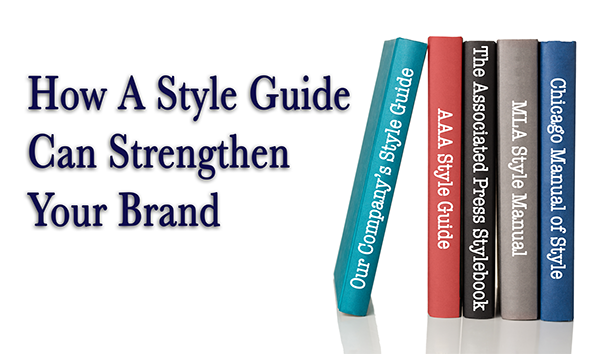Emails, social media posts, e-newsletters, websites, news releases, magazines, catalogs – if your association produces any of these, you probably have staff members creating copy content every day. And, your writers probably need to verify spelling, punctuation or proper use of industry terms occasionally.
Because of this, your association or business can benefit by creating your own style guide as a reference to answer those questions. A style guide will:
- Ensure your brand’s look is consistent
- Ensure sure all copy is written consistently
- Ensure copy is proofread consistently
- Help train new writers in your organization
- Avoid common punctuation mistakes
A style guide, also called a “manual of style,” isn’t meant to crimp a writer’s voice. Instead it helps maintain consistency for your readers.
 For that reason, your organization’s style guide should be more than a dictionary. It should almost be a how-to guide. If you need to create a style guide, start with the tips below. If you already have one, take some time to review it with these items in mind.
For that reason, your organization’s style guide should be more than a dictionary. It should almost be a how-to guide. If you need to create a style guide, start with the tips below. If you already have one, take some time to review it with these items in mind.
Decide on writing style
Consider what style your association should follow. For the most part, journalism-based writers use The Associated Press Stylebook and Briefing on Media Law. It dictates spelling of certain words, like spelling out the numbers zero to nine and using numerals for the rest, how to handle professional titles, and when and how to abbreviate certain words. It also aids with spelling and punctuation of possessives, and detailing what information needs to be included when you publish poll or survey results.
Many journalistic media outlets have created their own style guides based on the AP Stylebook and then add local spellings, acronyms and abbreviations. You can do the same by generating a list of words that are unique to your association or the industry you represent, and add them to your manual with definitions and usage examples.
For instance, if your association has a yearly meeting with a really long formal name, do you use the entire name for every reference? Or do you have an acronym you use? You might even decide to refer to it as “the convention.” As mentioned before, documenting these usage decisions in your style guide maintains consistency for your readers.
There are other style guides to consider if the AP Stylebook isn’t a good fit for your organization. The two most prevalent options are the Chicago Manual of Style and MLA Style. You can also search online for style guides for associations and businesses, and model yours after theirs.
Whichever style guide your association chooses as the basis for your wordsmiths, have at least one hard copy of it in the office or make sure everyone can access it online. Note that some online guides are free and some are subscription-based.
Add helpful information
In addition to definitions and usage tips, it is valuable to include production information. Think about proofreading. Is it policy at your association to print articles and items and route them for proofreading? If so, add details to your style guide describing your proofreading requirements, such as how many proofreaders need to review a piece and examples of the proofreaders’ marks you use. You may want to include the entire workflow for production, such as writing, proofreading and deadlines for all work along the process. If you have calendars for sending emails and social posts, include those also.
This section of your style guide should include the fonts, design elements and colors your organization has selected for its branding. A short tip sheet on writing good headlines, body copy, blog posts, social media posts and captions may also be in order.
Add contact information of the people who speak for your association, with their titles, phone numbers and email addresses.
If you have a magazine, editorial policies need to be included, starting with how to handle letters to the editor, submitted articles, and possibly advertising.
Putting it together
Place your association’s mission statement and vision statement at the beginning of your style guide. This keeps these statements handy for quick reference and may actually influence some of your style decisions.
For ease of use, state which style guide your organization will follow – AP, MLA or Chicago Manual of Style – and then list your changes and additions in alphabetical order. Next should come your proofreading, editorial and production policies. And once all of that is established, create a table of contents to assist staff members in finding what they need to know.
Once complete, your style guide can be stored on your computer network where everyone can access it, but also consider printing reference copies in case of computer network issues or accidental deletion.
Lastly, consider assigning a staff person to be responsible for periodic reviews and updates of your style guide. This will help ensure that your style guide is a living document that stays in sync with changes in your industry and helps you project an organizational brand that is in touch with your market and your readers.






